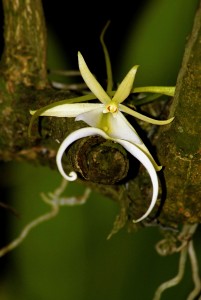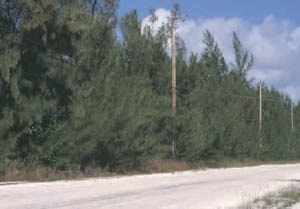 What is a bromeliad? A bromeliad is an air plant that can be found within the Everglades. Many are native to Florida. All of these bromeliads belong to the pineapple family.
What is a bromeliad? A bromeliad is an air plant that can be found within the Everglades. Many are native to Florida. All of these bromeliads belong to the pineapple family.
In the Everglades, the type that can be found are genus Tillandsia. All of this plants within this particular species of bromeliads have silvery-green leaves. The top of this species often resembles the top of a pineapple.
You can find these plants in abundance all over the parks, in all habitats, including dwarf cypress forests and cypress domes. They also can be found in hardwood hammocks, tree islands, mangrove forests, lone trees in sawgrass marshes, and on the branches of planted trees in parking lots of the park. You can’t escape these bromeliads!
Some bromeliads, like the giant airplant, hold water; they do this so when dry/drought conditions occur, they will have a water source to survive from. However, the giant airplant isn’t the only life form that benefits from this water. Insects, snakes, and tree frogs can be found in this plant’s leaves to take in the water.
Other bromeliads don’t old water, but they do have a hollow chamber in their base where acrobat ants make their home. The bromeliad gets its nutrients from the ants’ waste.
Not all bromeliads are insect/other creature-friendly. Some bromeliads, like the powdery catopsis, are covered with fine scales, which makes it hard for insects to get a grip on the leaves. The insects end up slipping into the water and drown. Some researchers believe these particular bromeliads may be a carnivorous plant for this reason.
Although bromeliads are abundant in the Everglades, they do have an “enemy.” The invasive Mexican bromeliad weevil feed on the tissue of bromeliads as a larva. This insect can easily decimate bromeliad populations; however, it has not been spotted in the Everglades since the 1990s.
Come see these bromeliads for yourself on an airboat tour! Captain Mitch’s Everglades airboat tours give you access to the expansive wildlife and plant life the region has to offer. To book your Everglades airboat tour today, click our everglades airboat tour page or call Captain Mitch’s Airboat Tours at 239-695-3377.
 The Ghost Orchid is one of the Everglades’ most rare and endangered plants.
The Ghost Orchid is one of the Everglades’ most rare and endangered plants. You might know that there’s a lot of seagrass around Florida and throughout the Everglades.; there’s 7 kinds of seagrass in Florida to be exact. But, did you know that this seagrass is dying? Much of the beautiful green, flowering seagrasses in the waters of the Everglades are turning brown and dying off. Last year, National Park Service researchers discovered a 40,000-acre section of seagrass in Florida Bay that is dying. Seagrass provides food and shelter for many different species for marine life, while also maintaining water quality. If this grass dies off, animals, fish, and even humans will be impacted negatively.
You might know that there’s a lot of seagrass around Florida and throughout the Everglades.; there’s 7 kinds of seagrass in Florida to be exact. But, did you know that this seagrass is dying? Much of the beautiful green, flowering seagrasses in the waters of the Everglades are turning brown and dying off. Last year, National Park Service researchers discovered a 40,000-acre section of seagrass in Florida Bay that is dying. Seagrass provides food and shelter for many different species for marine life, while also maintaining water quality. If this grass dies off, animals, fish, and even humans will be impacted negatively. The Florida Everglades have long been a popular tourist destination for visitors from around the United States and around the world. It is easy to see why so many people make this a must see place on their “bucket lists” since it is a unique, one of a kind landscape that gives you access to an incredibly diverse and sensitive environment. The Everglades is a wilderness preserve like no other, allowing visitors a chance to experience flora and fauna that can’t be seen many (if any) other place on earth.
The Florida Everglades have long been a popular tourist destination for visitors from around the United States and around the world. It is easy to see why so many people make this a must see place on their “bucket lists” since it is a unique, one of a kind landscape that gives you access to an incredibly diverse and sensitive environment. The Everglades is a wilderness preserve like no other, allowing visitors a chance to experience flora and fauna that can’t be seen many (if any) other place on earth. The Everglades is an amazing and pristine ecosystem that is a unique biome that is home to a huge wealth of different flora and fauna. For nature lovers, outdoor enthusiasts, and adventure seekers alike, the Everglades is a one-of-a-kind place that is unmatched. A lot of people, when planning a vacation to the Everglades, choose to experience Everglades National Park, which is a protected area of the Everglades where plants, animals, birds, and fish are protected and conserved.
The Everglades is an amazing and pristine ecosystem that is a unique biome that is home to a huge wealth of different flora and fauna. For nature lovers, outdoor enthusiasts, and adventure seekers alike, the Everglades is a one-of-a-kind place that is unmatched. A lot of people, when planning a vacation to the Everglades, choose to experience Everglades National Park, which is a protected area of the Everglades where plants, animals, birds, and fish are protected and conserved. There are around 18,000 plants native to North America. These plants provide food, fiber, and habitats that people and wildlife depend on. Unfortunately, many invasive (non-native species) plants have become a threat to the native plants and are the second greatest threat (next to humans) to them. Many of these invasive plants have found their way into the Everglades. The Park staff work throughout the year to remove these plants whenever they can in order to protect the natural habitat. One of these invasive species is the Australian Pine (Casuarina equisetifolia).They have invaded thousands of acres in southern Florida.
There are around 18,000 plants native to North America. These plants provide food, fiber, and habitats that people and wildlife depend on. Unfortunately, many invasive (non-native species) plants have become a threat to the native plants and are the second greatest threat (next to humans) to them. Many of these invasive plants have found their way into the Everglades. The Park staff work throughout the year to remove these plants whenever they can in order to protect the natural habitat. One of these invasive species is the Australian Pine (Casuarina equisetifolia).They have invaded thousands of acres in southern Florida. Did you know cacti and succulents grow in the Everglades? Surprising, right? These plants don’t just grow in deserts. In fact, many grow in tropical and subtropical climates. The species, native to the Everglades, thrive off the frequent rainfall and the sunny dates. They require a balance of wet and dry conditions.
Did you know cacti and succulents grow in the Everglades? Surprising, right? These plants don’t just grow in deserts. In fact, many grow in tropical and subtropical climates. The species, native to the Everglades, thrive off the frequent rainfall and the sunny dates. They require a balance of wet and dry conditions. also called the Pinelands, are a disappearing habitat in the Everglades and all South Florida. These rocklands are found on limestone substrates. These Pinelands once covered around 185,000 acres in Miami-Dade County, and by 1996 only 2 percent of this forest remained in the urbanized areas of the county and outside the border of the Everglades National Park. The Florida Fish and Wildlife Conservation Commission (FWC) has recently proposed a list of four more plants in the Florida pine rockland ecosystem to receive federal protection. Three at risk species include: The Everglades bully, the Florida pineland crabgrass, and the pineland sandmat; one species is being considered as endangered: the Florida prairie-clover.
also called the Pinelands, are a disappearing habitat in the Everglades and all South Florida. These rocklands are found on limestone substrates. These Pinelands once covered around 185,000 acres in Miami-Dade County, and by 1996 only 2 percent of this forest remained in the urbanized areas of the county and outside the border of the Everglades National Park. The Florida Fish and Wildlife Conservation Commission (FWC) has recently proposed a list of four more plants in the Florida pine rockland ecosystem to receive federal protection. Three at risk species include: The Everglades bully, the Florida pineland crabgrass, and the pineland sandmat; one species is being considered as endangered: the Florida prairie-clover. The Everglades is home to an array of plants that thrive in the wet, subtropical climate. Although mangroves and grasses come to many people’s minds when thinking about plant life in the Everglades, we’d like to profile a plant that many people might not know about that is native to the area: the pond apple.
The Everglades is home to an array of plants that thrive in the wet, subtropical climate. Although mangroves and grasses come to many people’s minds when thinking about plant life in the Everglades, we’d like to profile a plant that many people might not know about that is native to the area: the pond apple. The Everglades is an internationally protected wilderness that hosts flora and fauna not found anywhere else in the world. Its diverse ecosystem weaves intricate webs of trees and marshes amid freshwater estuaries, all of which bleed into the Gulf of Mexico. There are nine habitats in the Everglades, and each plays an important role in the vitality of the area’s plants and animals. From swamps to pine forests, here’s what you can expect to find in each habitat, and which plant and wildlife can be found where:
The Everglades is an internationally protected wilderness that hosts flora and fauna not found anywhere else in the world. Its diverse ecosystem weaves intricate webs of trees and marshes amid freshwater estuaries, all of which bleed into the Gulf of Mexico. There are nine habitats in the Everglades, and each plays an important role in the vitality of the area’s plants and animals. From swamps to pine forests, here’s what you can expect to find in each habitat, and which plant and wildlife can be found where:





